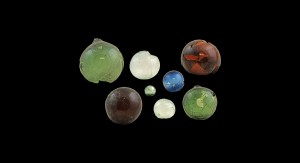Witch balls date back to the 1600s. Found along the I-95 corridor in Philadelphia, these examples range from 1.25–7″ in diameter. Originally called watch balls, the glass spheres were silver-lined, used as storage containers for salt, and hung in chimneys to keep the salt dry. It was considered a misfortune to have a ball break, and the hanging of watch balls became closely associated with warding off evil and bad luck. By the 18th century, it became popular to hang these glass spheres and display them on pedestals around the house. Protection became their primary purpose, making them commonly known as witch balls. English settlers brought this tradition to the colonies, and witch balls were manufactured in the New Jersey and Philadelphia areas as early as 1820. Witch balls lined with silver were thought to frighten away evil spirits when they saw their own reflections. Others were made with colored glass, either solid or swirled. The positive energy associated with this style was thought to attract negative energy and mesmerize evil spirits, trapping them inside. Vendors sold witch balls in the height of their popularity, and some glassworks made them as whimsical “end-of-day” items after regular production quotas had been met. By the 20th century, the popularity of witch balls faded in the United States, but continued in England until World War II.
